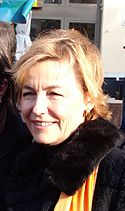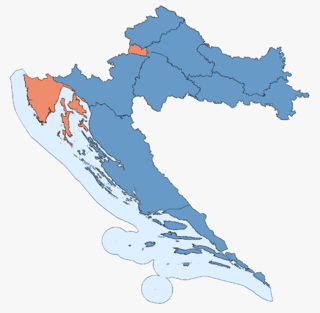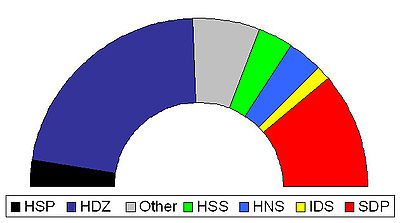- Croatian parliamentary election, 2003
-
Croatian parliamentary election, 2003 
2000 ←
members23 November 2003 → 2007
membersAll 151 seats to Hrvatski sabor First party Second party 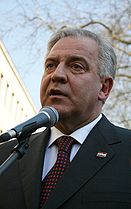
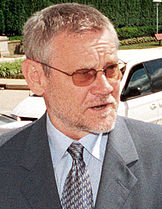
Leader Ivo Sanader Ivica Račan Party HDZ SDP Last election 46 seats, 30.46% 49 seats, 32.5%
(SDP, IDS, LS)Seats won 66 43
(SDP-led coalition)Seat change  20
20 6
6Popular vote 840,692 560,593 Percentage 33.9% 22.6% Third party Fourth party Leader Vesna Pusić Zlatko Tomčić Party HNS HSS Last election 5 seats, 3.3%
(HNS, PGS, SBHS)17 seats, 11.26% Seats won 11
(HNS-led coalition)10 Seat change  6
6 7
7Popular vote 198,781 177,359 Percentage 8.0% 7.2%
Results of the election in each of the ten electoral districts of Croatia: the party with the majority of votes in each electoral unit.
HDZ: blue; SDP coalition: red
Prime Minister before election
Subsequent Prime Minister
1995 election • MPs 2000 election • MPs 2003 election • MPs 2007 election • MPs Croatia 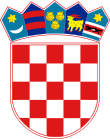
This article is part of the series:
Politics and government of
CroatiaConstitutionJudiciaryExecutive- President (List)
- Ivo Josipović
- Government (List)
- Prime Minister
- Jadranka Kosor
- Cabinet
- Prime Minister
- Croatian Democratic Union (HDZ)
- Social Democratic Party (SDP)
- Croatian People's Party -
Liberal Democrats (HNS-LD) - Croatian Peasant Party (HSS)
- Istrian Democratic Assembly (IDS)
- Croatian Democratic Alliance
of Slavonia and Baranja (HDSSB) - Croatian Social Liberal Party (HSLS)
- Croatian Party of Pensioners (HSU)
- Croatian Party of Rights (HSP)
Divisions
Elections for the Croatian Parliament were held on November 23, 2003.
Contents
General information
There are 10 electoral units based on geography and population. In each unit, 14 candidates are elected on proportional electoral system. The election threshold is 5%.
In addition, 8 candidates are elected to represent national minorities.
The citizens that live outside Croatian borders vote in a separate electoral unit. The number of representatives elected from this unit will be determined after the elections, based on how many people actually vote in Croatia, so that there is equal value of votes both inside and outside Croatia. For reference, the number of diaspora seats in the 2000-2003 Sabor was six.
Total: 140 domestic seats + 8 minority seats + 4 diaspora seats.
Distribution of minority seats:
- Serbs: 3
- Hungarians: 1
- Italians: 1
- Czechs and Slovaks: 1
- Austrians, Bulgarians, Germans, Poles, Roma, Romanians, Rusyns, Russians, Turks, Ukrainians, Vlachs and Jews: 1
- Albanians, Bosniaks, Montenegrins, Macedonians, Slovenes: 1
Parties and coalitions
Pre-election coalitions:
- DC and HSLS, in all electoral units
- SDP and IDS, in the 8th electoral unit (the county of Istria et al.)
- HB and HIP, in all electoral units
- SDP and Libra in the 2nd, 3rd, 4th and 10th electoral unit
- SDP and LS, in the 4th and 6th electoral unit
- HNS and SBHS, in the 4th and 5th electoral unit (counties of Slavonia)
- HNS and PGS, in the 7th and 8th electoral unit (Northern seacoast counties)
Summary of votes and seats
Summary of the 23 November 2003 Croatian Parliament (Hrvatski Sabor) election results Parties and coalitions Votes % Seats % Seat trend Seat change (%) Croatian Democratic Union (Hrvatska demokratska zajednica) 840,692 33.9 66 43.71 
+13,25 Coalition: Social Democratic Party (Socijaldemokratska partija Hrvatske) 560,593 22.6 34 22.52 
-5,96 Istrian Democratic Assembly (Istarski demokratski sabor/Dieta democratica Istriana) 4 2.65 
0 Party of Liberal Democrats (Libra - Stranka liberalnih demokrata) 3 1.99 Liberal Party (Liberalna stranka) 2 1.32 
0 Coalition: Croatian People's Party (Hrvatska narodna stranka) 198,781 8.0 10 6.62 
+5.30 Alliance of Primorje - Gorski Kotar (Primorsko-goranski savez) 1 0.66 
-0.66 Slavonia-Baranja Croatian Party (Slavonsko-baranjska hrvatska stranka) - 0.00 
-0.66 Croatian Peasant Party (Hrvatska seljačka stranka) 177,359 7.2 10 6.62 
-4.64 Coalition: Croatian Party of Rights (Hrvatska stranka prava) 157,987 6.4 8 5.30 
+2,65 Zagorje Democratic Party (Zagorska demokratska stranka) - 0.00 Međimurje Party (Međimurska stranka) - 0.00 Coalition: Croatian Social Liberal Party (Hrvatska socijalno liberalna stranka) 100,335 4.0 2 1.32 
-15.24 Democratic Centre (Demokratski centar) 1 0.66 Croatian Pensioners' Party (Hrvatska stranka umirovljenika) 98,537 4.0 3 1.99 Independent Democratic Serb Party (Samostalna demokratska srpska stranka) - - 3 1.99 Coalition: Croatian Democratic Peasants Party (Hrvatska demokratska seljačka stranka) 24,872 1.0 1 0.66 Croatian Democratic Centre (Hrvatski demokratski centar) - 0.00 Democratic Prigorje-Zagreb Party (Demokratska prigorsko-zagrebačka stranka) - 0.00 Democratic Union of Hungarians of Croatia (Demokratska zajednica Mađara Hrvatske) - - 1 0.66 German People's Union (Njemačka narodnosna zajednica) - - 1 0.66 Party of Democratic Action of Croatia (Stranka demokratske akcije Hrvatske) - - 1 0.66 Non-partisans 4 2.65 Total (turnout 61.7 %) 2,478,967 151 100.00 Invalid Votes 41,041 Votes Cast 2,520,008 Registered Voters 4,087,553 Source: Izbori.hr and IFES. The number of diaspora mandates is reduced by 2 compared to previous elections due to somewhat lower diaspora turnout. Due to distribution according to the d'Hondt method, the independent lists for diaspora won't be allocated seats, even though they received over 5% of total votes.
Ivo Sanader of Croatian Democratic Union HDZ was appointed as Prime Minister by the President and confirmed by the Croatian Parliament.
The new Government was formed of 13 HDZ ministers and 1 of Democratic Centre.
See also
External links
Elections and referendums in Croatia Kingdom of Croatia-Slavonia Kingdom of Dalmatia Parliamentary elections Presidential elections Chamber of Counties elections Local elections Referendums (For the 1918–1989 period see Elections in Yugoslavia)Categories:- Elections in Croatia
- 2003 elections in Europe
- 2003 in Croatia
- President (List)
Wikimedia Foundation. 2010.

